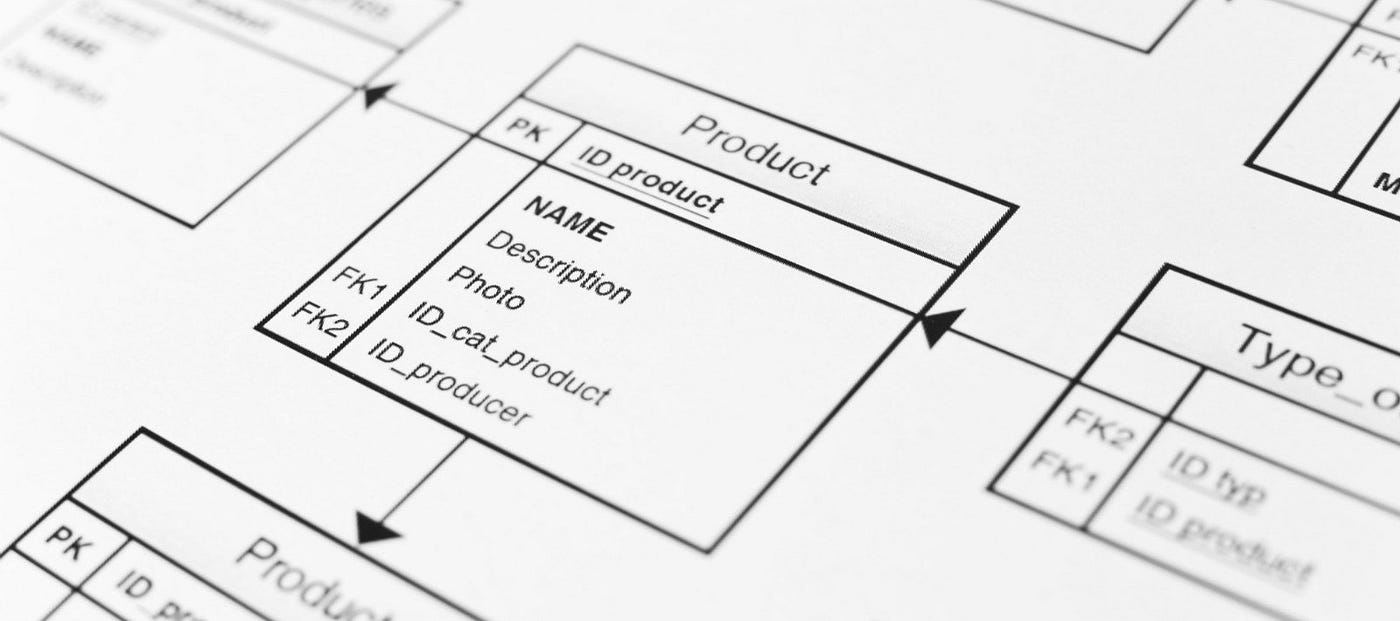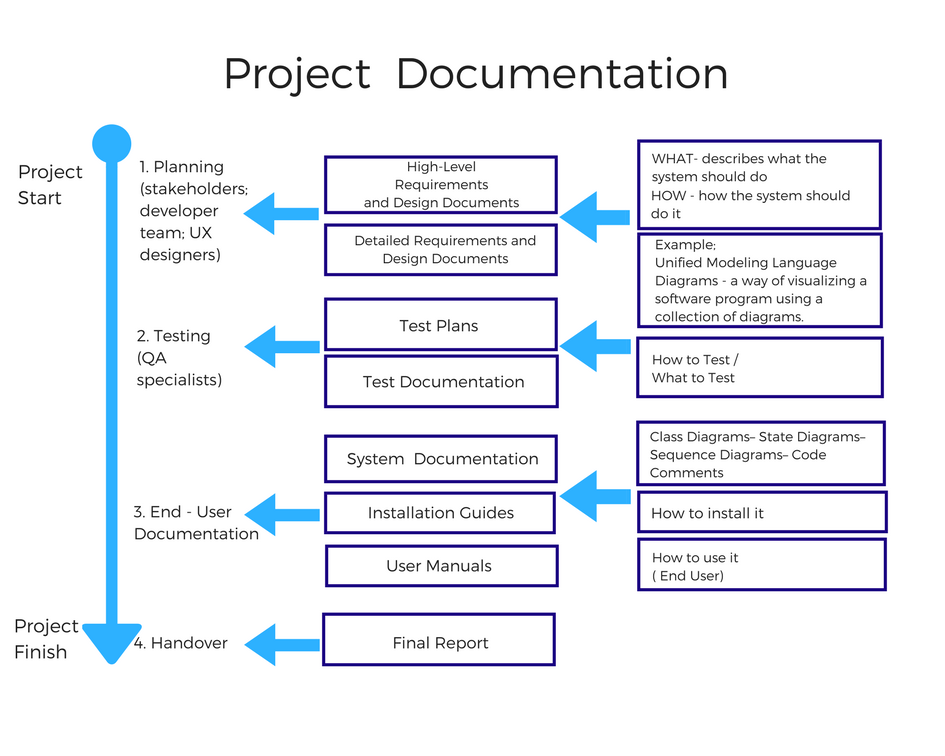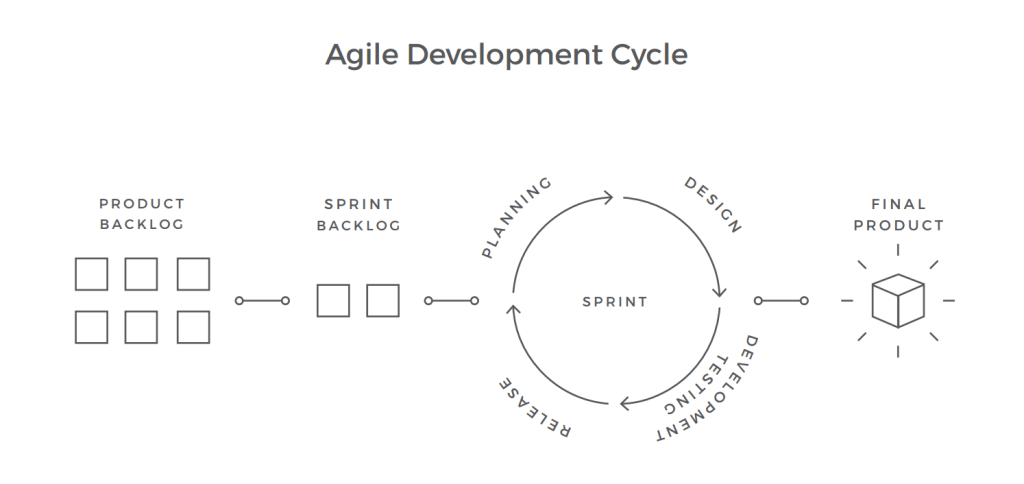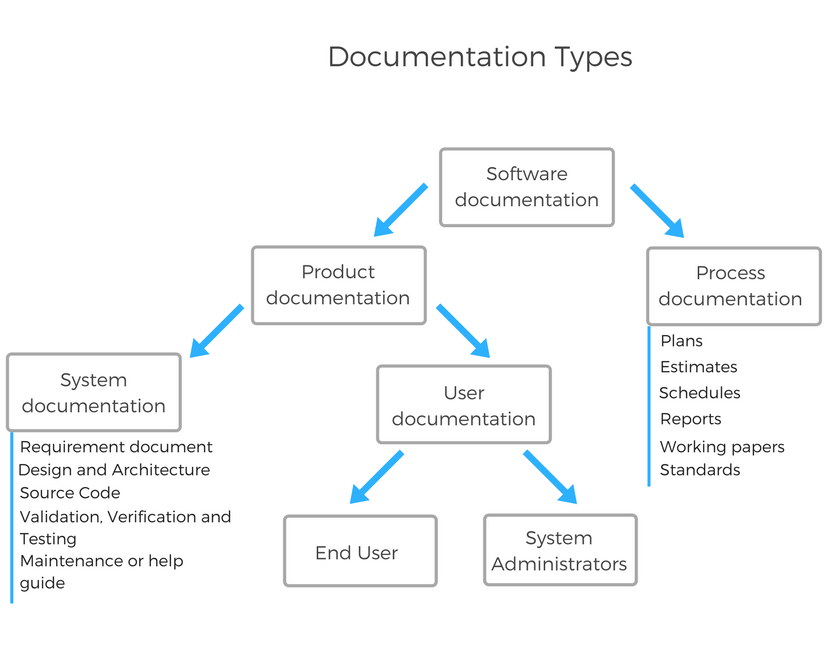which of the following describes what the system is required to do?​
Software Documentation Types and Best Practices

Documentation in software engineering is the umbrella term that encompasses all written documents and materials dealing with a software production'south evolution and use. All software development products, whether created by a small team or a large corporation, require some related documentation. And different types of documents are created through the whole software development lifecycle (SDLC). Documentation exists to explain product functionality, unify project-related information, and allow for discussing all meaning questions arising between stakeholders and developers.

On top of that, documentation errors can set gaps between the visions of stakeholders and engineers and, every bit a consequence, a proposed solution won't come across stakeholders expectations. Consequently, managers should pay a lot of attention to documentation quality.
Active and waterfall approaches
The documentation types that the team produces and its scope depend on the software development arroyo that was chosen. There are two main ones: agile and waterfall. Each is unique in terms of accompanying documentation.
Waterfall is a linear method with singled-out goals for each development phase. Teams that employ waterfall spend a reasonable corporeality of time on production planning in the early on stages of the project. They create an extensive overview of the chief goals and objectives and plan what the working process will look like. Waterfall teams strive to create detailed documentation earlier any of the technology stages begin. Careful planning works well for projects with little to no changes in progress every bit it allows for precise budgeting and fourth dimension estimates. However, waterfall planning has proven to be ineffective for long-term evolution as it doesn't account for possible changes and contingencies on the go. According to PMI's ninth Global Projection Management Survey, the Agile approach is used by 71 percentage of organizations for their projects.

The agile arroyo is based on teamwork, close collaboration with customers and stakeholders, flexibility, and ability to quickly respond to changes. The basic building blocks of agile evolution are iterations; each one of them includes planning, analysis, design, evolution, and testing. The agile method doesn't require comprehensive documentation at the beginning. Managers don't need to plan much in accelerate because things can change as the projection evolves. This allows for just-in-time planning. As one of the Agile Manifesto values suggests, putting — "working software over comprehensive documentation -", the thought is to produce documentation with information that is essential to move forrad, when it makes the most sense.
Today, agile is the most common practice in software development, and then we'll focus on documentation practices related to this method.
Types of documentation
The main goal of effective documentation is to ensure that developers and stakeholders are headed in the same direction to accomplish the objectives of the project. To reach them, plenty of documentation types exist.
Adhering to the following classifications.

All software documentation can exist divided into two main categories:
- Product documentation
- Process documentation
Product documentation describes the product that is being developed and provides instructions on how to perform various tasks with information technology. Production documentation can be broken downward into:
- System documentation and
- User documentation
Arrangement documentation represents documents that draw the system itself and its parts. Information technology includes requirements documents, design decisions, architecture descriptions, program source lawmaking, and help guides.
User documentation covers manuals that are mainly prepared for cease-users of the product and system administrators. User documentation includes tutorials, user guides, troubleshooting manuals, installation, and reference manuals.
Process documentation represents all documents produced during development and maintenance that depict… well, procedure. The common examples of procedure documentation are projection plans, test schedules, reports, standards, meeting notes, or even business organization correspondence.
The main difference between process and product documentation is that the first one tape the procedure of development and the 2d 1 describes the product that is being adult.
Production: System documentation
System documentation provides an overview of the system and helps engineers and stakeholders empathise the underlying technology. It usually consists of the requirements document, architecture blueprint, source code, validation docs, verification and testing info, and a maintenance or assist guide. It's worth emphasizing that this list isn't exhaustive. Then, let's have a look at the details of the main types.
Requirements document
A requirements certificate provides data about the system functionality. Generally, requirements are the statements of what a arrangement should practice. Information technology contains business rules, user stories, use cases, etc. This document should be clear and shouldn't be an extensive and solid wall of text. Information technology should contain plenty to outline the product's purpose, its features, functionalities, and behavior.
The best practice is to write a requirement document using a single, consequent template that all team members adhere to. The i spider web-page form will assist you lot keep the document concise and save the time spent on accessing the information. Here'southward a look at an example of a one-spider web-page product-requirements document to sympathise various elements that should be included in your PRD. Nevertheless, you should remember that this isn't the one and only way to compile this document.

One web-page product-requirements document created by using Atlassian Confluence , the content collaboration software
Here are the main recommendations to follow:
- Roles and responsibilities. Start your document with the information virtually project participants including a production owner, team members, and stakeholders. These details will clarify responsibilities and communicate the target release goals for each of the team members.
- Team goals and a concern objective. Define the most important goals in a short point form.
- Background and strategic fit. Provide a brief explanation about the strategic aim of your deportment. Why are you lot building the production? How do your deportment affect the production development and align with company's goals?
- Assumptions. Create a list of technical or business assumptions that the squad might have.
- User Stories. Listing or link user stories that are required for the project. A user story is a certificate written from the point of view of a person using your software product. The user story is a brusk description of customer actions and results they want to achieve.
- User interaction and design. Link the design explorations and wireframes to the page.
- Questions. As the squad solves the problems forth the project progression, they inevitably have many questions arising. A good practice is to tape all these questions and runway them.
- Not doing. List the things which you aren't doing now but programme on doing shortly. Such a list will assist you organize your teamwork and prioritize features.
Make all this data more comprehensive by using the following practices:
- Use links and anchors. They will help you lot make the certificate easier to read and search as readers will exist able to comprehend the information gradually. For instance, you can provide links to customer interviews and anchors to previous discussions or other external information related to the project.
- Employ diagramming tools to meliorate communicate the problems to your team. People are more likely to perceive information by looking at the images than reading an extensive document. Different visual models will help you to perform this task and outline requirements more effectively. Yous tin can incorporate diagrams into your requirements procedure using the following software diagramming tools: Visio, Gliffy, Balsamiq, Axure or SmartArt in Microsoft Office.
Software architecture document
Software architecture design documents include the main architectural decisions. We don't recommend listing everything, but rather focus on the most relevant and challenging ones. An constructive blueprint and architecture document comprises the following information sections:
Design document template. Talk over and form a consensus with stakeholders regarding what needs to be covered in the architecture blueprint document before it has been created and use a defined template to map architectural solutions.
Compages & Design Principles. Underline the guiding compages and pattern principles with which you volition engineer the product. For instance, if you plan to structure your solution using microservices architecture, don't forget to specifically mention this.
User Story clarification. Connect user stories with associated business processes and related scenarios. You should try to avoid technical details in this section.
Solution details. Describe the contemplated solution past list planned services, modules, components, and their importance.
Diagrammatic representation of the solution. Place the diagrams that demand to be created to help understand and communicate the structure and blueprint principles.
Source code document
A source code certificate is a technical section that explains how the code works. While it's non necessary, the aspects that have the greatest potential to confuse should exist covered. The main users of the source code documents are software engineers.
Source code documents may include but are not limited to the following details:
- HTML generation framework and other frameworks applied
- Blazon of data bounden
- Design pattern with examples (e.grand. model-view-controller)
- Security measures
- Other patterns and principles
Endeavor to keep the document simple by making short sections for each element and supporting them with brief descriptions.
Quality balls documentation
There are different types of testing documents in agile. Nosotros have outlined the virtually common:
- Test strategy
- Examination program
- Examination instance specifications
- Exam checklists
A exam strategy is a document that describes the software testing approach to reach testing objectives. This document includes information about team structure and resource needs along with what should be prioritized during testing. A exam strategy is unremarkably static as the strategy is defined for the entire development scope.
A test plan usually consists of one or two pages and describes what should exist tested at a given moment. This document should incorporate:
- The list of features to be tested
- Testing methods
- Timeframes
- Roles and responsibilities (e.g. unit tests may exist performed either past the QA team or by engineers)
A test case specifications document is a set of detailed actions to verify each feature or functionality of a product. Usually, a QA squad writes a separate specifications certificate for each product unit of measurement. Test case specifications are based on the approach outlined in the test plan. A practiced practice is to simplify specifications description and avert examination case repetitions.
Examination checklist is a listing of tests that should exist run at a detail time. It represents what tests are completed and how many take failed. All points in the test checklists should exist defined correctly. Try to group examination points in the checklists. This arroyo will assist yous keep track of them during your piece of work and not lose whatever. If it helps testers to bank check the app correctly, y'all can add comments to your points on the list.
Maintenance and help guide
This document should draw known problems with the system and their solutions. It too should stand for the dependencies between different parts of the arrangement.
Product: User documentation
Every bit the name suggests, user documentation is created for product users. However, their categories may also differ. So, you should structure user documentation according to the different user tasks and dissimilar levels of their experience. Generally, user documentation is aimed at two big categories:
- end-users
- system administrators
The documentation created for finish-users should explicate in the shortest way possible how the software tin help solve their issues. Some parts of user documentation, such every bit tutorials and onboarding, in many big customer-based products are replaced with onboarding preparation. Nevertheless, there are still complex systems remaining that crave documented user guides.
The online form of user documentation requires technical writers to be more imaginative. Online cease-user documentation should include the following sections:
- FAQs
- Video tutorials
- Embedded assistance
- Support Portals
In order to provide the all-time service for cease-users, you should collect your customer feedback continuously. The wiki system is one of the more useful practices. It helps to maintain the existing documentation. If you use the wiki system you won't need to export documents to presentable formats and upload them the servers. You can create your wiki pages using a wiki markup language and HTML lawmaking.
Organization administrators' documents don't need to provide information virtually how to operate the software. Usually, assistants docs encompass installation and updates that help a system administrator with product maintenance. Hither are standard arrangement administrators documents:
- Functional description — describes the functionalities of the product. Most parts of this certificate are produced later on consultation with a user or an owner.
- Organization admin guide — explains unlike types of behaviors of the system in different environments and with other systems. Information technology besides should provide instructions how to bargain with malfunction situations.
Process Documentation
Process documentation covers all activities surrounding the product evolution. The value of keeping process documentation is to brand development more organized and well-planned. This co-operative of documentation requires some planning and paperwork both before the project starts and during the development. Hither are mutual types of process documentation:
Plans, estimates, and schedules. These documents are unremarkably created before the project starts and can be contradistinct as the product evolves.
Reports and metrics. Reports reflect how time and human resources were used during development. They can be generated on a daily, weekly, or monthly ground. Consult our article on active delivery metrics to learn more than about process documents such equally velocity chats, dart burndown charts, and release burndown charts.
Working papers. These documents exist to record engineers' ideas and thoughts during project implementation. Working papers usually incorporate some information virtually an engineer's code, sketches, and ideas on how to solve technical issues. While they shouldn't be the major source of information, keeping track of them allows for retrieving highly specific project details if needed.
Standards. The section on standards should include all coding and UX standards that the squad adheres to along the project's progression.
The bulk of process documents are specific to the detail moment or phase of the process. Every bit a result, these documents quickly become outdated and obsolete. But they withal should exist kept every bit role of development because they may go useful in implementing similar tasks or maintenance in the future. Too, process documentation helps making the whole development more than transparent and easier to manage.
The chief goal of process documentation is to reduce the corporeality of system documentation. In order to achieve this, write the minimal documentation plan. List the fundamental contacts, release dates, and your expectations with assumptions.
General practices for all types of documents
There are several mutual practices that should be applied to all the types of documents nosotros discussed in a higher place:
Write just enough documentation
Y'all should observe a residuum betwixt no documentation and excessive documentation. Poor documentation causes many errors and reduces efficiency in every phase of a software product development. At the same fourth dimension, there is no need to provide an affluence of documentation and to repeat data in several papers. Merely the most necessary and relevant information should be documented. Finding the correct residue as well entails analyzing the project'south complexity before evolution starts.
Documentation is an ongoing process
This means that you should keep your documentation upward-to-appointment. It is very important as documents that aren't current automatically lose their value. If requirements change during software development, you lot need to ensure that there's a systematic documentation update process that includes data that has changed. You lot can use automated version control to manage this procedure more efficiently.
Documentation is the collaborative effort of all team members
The agile method is based on a collaborative approach to creating documentation. If y'all desire to attain efficiency, interview programmers and testers about the functionalities of the software. Then, after you take written some documentation, share it with your squad and become feedback. To go more information try to comment, ask questions, and encourage others to share their thoughts and ideas. Every team member tin can make a valuable contribution to documents you produce.
Hire a tech writer
If you can, information technology will be the worth hiring an employee who will take care of your documentation. The person who more often than not does this chore is called a technical writer. A tech author with an applied science background tin gather data from developers without requiring someone to explain in detail what is going on. It'south also worth embedding a technical writer as team member, locating this person in the same office to establish close cooperation. He or she will be able to have part in regular meetings and discussions.
Final word
The agile methodology encourages applied science teams to always focus on delivering value to their customers. This cardinal principle must also be considered in the process of producing software documentation. Good software documentation should exist provided whether information technology is a specifications document for programmers and testers or software manuals for terminate users. Comprehensive software documentation is specific, curtailed, and relevant.
As we have mentioned above, it's non obligatory to produce the unabridged set of documents described in this article. You lot should rather focus but on those documents that directly assistance achieve project objectives.
Source: https://blog.prototypr.io/software-documentation-types-and-best-practices-1726ca595c7f
0 Response to "which of the following describes what the system is required to do?​"
Post a Comment